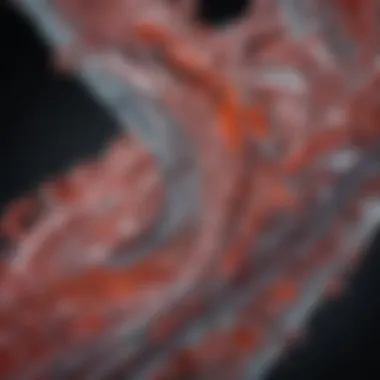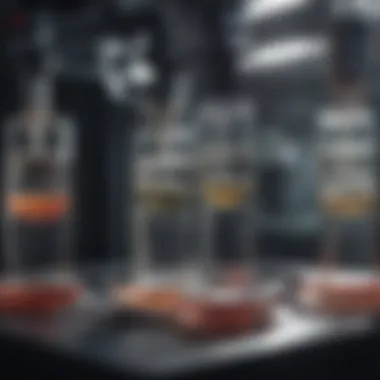Exploration of Retronectin: Insights into Takara's Product


Intro
Retronectin, a recombinant extracellular matrix (ECM) protein produced by Takara, has gained recognition for its pivotal role in cell biology. Its unique properties facilitate numerous applications in research and clinical practice. As scientists focus on the development of more effective therapeutic strategies, understanding Retronectin becomes essential. This article aims to provide a comprehensive exploration of the structural, biochemical, and functional nuances of this protein.
Research Overview
Summary of Key Findings
Retronectin functions as an essential component in cell adhesion, differentiation, and migration. Several studies have highlighted its capability to support various cell types, which is crucial in both basic and applied biological research. Notable findings include:
- Retronectin enhances the attachment of cells to surfaces, promoting optimal growth conditions.
- Its structure resembles that of natural ECM proteins, facilitating interactions with cell surface receptors.
- The protein plays a significant role in tissue engineering by aiding in the development of three-dimensional cellular structures.
Research Objectives and Hypotheses
The primary objectives of this research involve:
- Identifying the structural characteristics of Retronectin that contribute to its biological functions.
- Examining its roles in different cell types and how it affects cell behavior under varying conditions.
- Evaluating its potential in developing innovative therapeutic modalities.
The hypothesis posits that understanding Retronectin’s properties can unlock its full potential in advancing regenerative medicine and tissue engineering, making it an invaluable asset in modern biotechnological applications.
Methodology
Study Design and Approach
The methodology for exploring Retronectin encompasses both experimental and theoretical components. Researchers have utilized techniques such as:
- Protein purification and characterization: Employing methods like affinity chromatography to isolate Retronectin from other proteins.
- Cell culture experiments: Evaluating cell adhesion and migration in controlled lab environments.
Data Collection Techniques
Data collection relies on both qualitative and quantitative techniques, including:
- Microscopy for visualizing cellular interactions with Retronectin.
- Biochemical assays to measure cellular responses and growth metrics.
"Understanding Retronectin will guide future research, impacting therapeutic exploration and precision medicine."
Finale
Retronectin offers vast potential for researchers, clinicians, and biotechnology experts. Its ability to influence cell behavior and contribute to tissue engineering illustrates its importance in scientific innovation. An in-depth understanding of Retronectin's properties will promote effective application and further exploration in advanced therapeutic strategies.
Prelude to Retronectin
Retronectin is more than just a protein; it embodies a vital tool in biotechnological and biomedical research. The exploration of Retronectin helps illuminate its unique characteristics and multifunctionality, making it a cornerstone in various applications. This section serves to introduce Retronectin, explaining its significance within the context of this article. The following subsections will delve into its definition, origin, and the pivotal role of Takara in advancing bioresearch through this product.
Definition and Origin
Retronectin is classified as a recombinant extracellular matrix protein. Its primary function involves facilitating interactions between cells and their microenvironment, which is critical for various biological processes including cell adhesion, migration, and differentiation. The origin of Retronectin can be traced back to studies of the extracellular matrix, revealing how specific proteins govern cellular behavior. It was developed by Takara, a leader in the field of life science research and biotechnology. Their research established the underlying molecular features of Retronectin, ensuring that it could replicate the effects observed in natural extracellular matrices. Understanding the definition and origin of Retronectin is essential, as it sets the framework for its biochemical roles and practical applications in scientific research.
Takara's Role in Bioresearch
Takara has been instrumental in the development and distribution of Retronectin. As a prominent player in bioresearch, the company has leveraged its expertise to enhance the accessibility and utility of this protein. Takara's commitment to research innovation has facilitated numerous studies that utilize Retronectin. This engagement has not only propelled advancements in basic and applied research but also nurtured collaborations across the scientific community. By providing reliable products and resources, Takara has enabled researchers to explore the expansive potential of Retronectin in diverse fields, such as regenerative medicine and tissue engineering. Targeting the specific needs of bioresearchers, Takara continues to refine its offerings, ensuring that Retronectin remains a pivotal player in inquiry and discovery.


"Takara’s dedication to advancing bioresearch exemplifies how innovative products like Retronectin can drive scientific discovery and application."
In summary, the exploration of Retronectin serves as a gateway to understanding its myriad applications, underpinned by a solid foundation established by Takara in the field of biotechnological advancements.
Structural Characteristics of Retronectin
Understanding the structural characteristics of Retronectin is vital for grasping its role in various biological applications. This section will cover its molecular composition and the methods used for its recombinant production. These elements are essential as they directly influence the protein's functionality and utility in research.
Molecular Composition
Retronectin, as a recombinant extracellular matrix protein, has a complex molecular structure. It is primarily composed of around 1200 amino acids that form a polypeptide chain. This chain features multiple domains, including fibronectin-type III repeats. These repeats are significant because they facilitate interactions between cells and the extracellular matrix. The domains contribute to Retronectin's ability to promote cell attachment and migration, both crucial for cellular processes.
The molecular structure of Retronectin also enables it to interact with various ligands, including integrins and growth factors. These interactions are important for cell signaling, helping cells respond to their environment. The proper folding and arrangement of these molecular components determine the functionality of Retronectin in any application, including tissue engineering and regenerative medicine.
Recombinant Production Techniques
The production of Retronectin involves sophisticated recombinant DNA technology. This technique allows researchers to synthesize proteins in an efficient manner. The process begins with the insertion of the gene coding for Retronectin into expression vectors, commonly using Escherichia coli or mammalian cells as hosts.
Once the vector is introduced into the host organism, the cells use their machinery to produce Retronectin. This production can be optimized by controlling factors such as temperature and nutrient availability, ensuring high yields. After expression, purification techniques are applied to isolate Retronectin from other cellular components.
Several purification strategies are commonly employed. These include affinity chromatography, which selectively binds the protein, and various methods like ion-exchange chromatography that exploit differences in charge. The combination of these techniques results in high-purity Retronectin, suitable for research and therapeutic applications.
The recombinant production of Retronectin is a crucial advancement in biotechnology, facilitating its use across multiple fields.
In summary, the structural characteristics of Retronectin, including its molecular composition and the recombinant production techniques, are foundational to its effectiveness in scientific research. Understanding these aspects is essential for utilizing this protein in various biological applications.
Biochemical Functions of Retronectin
The biochemical functions of Retronectin are fundamental to understanding its role in various biological processes. This section highlights its importance and explains how it facilitates key cellular movements and interactions. Since Retronectin is a recombinant extracellular matrix protein, its functionalities play a significant role in both in vitro and in vivo biological environments.
Cell Adhesion Properties
Retronectin´s cell adhesion properties are one of its most critical features. It has a distinct ability to promote the attachment of various cell types, including fibroblasts and stem cells, to surfaces. The protein binds to specific integrins present on cell membranes. This interaction is crucial for establishing a stable environment for cell growth and proliferation. Without adequate cell adhesion, the cellular structures can become compromised, leading to varied issues in tissue development and healing.
The enhancement of cell adhesion through Retronectin can be particularly beneficial in laboratory settings. For example, employing Retronectin can improve the yield and viability of stem cells during isolation from tissues. The resulting cellular structures exhibit increased functionality, which is vital for regenerative medicine applications. Moreover, researchers have observed that Retronectin aids in maintaining cell morphology and phenotype, further solidifying its relevance in foundational biological studies.
Influence on Cell Migration
Cell migration is another significant biochemical function of Retronectin. This protein promotes not only adhesion but also facilitates the movement of cells within their extracellular matrix environment. Understanding cell migration is essential, as it plays a central role in physiological processes such as wound healing and embryonic development. Retronectin enhances cell mobility through various signaling pathways.
When cells adhere to Retronectin, it triggers intracellular signals that lead to cytoskeletal rearrangements necessary for migration. This property allows for more efficient tissue repair as cells can migrate towards the site of injury. In addition, by enabling cellular movements, Retronectin can assist in the formation of new vasculature, thereby promoting better tissue regeneration.
"Retronectin not only provides an anchoring point for cells but also supports their dynamic movement across different environments, highlighting its dual functionality."
In summary, the biochemical functions of Retronectin—especially its cell adhesion properties and influence on cell migration—are pivotal to many research applications. By understanding these properties, scientists can harness the full potential of Retronectin to impact diverse fields, from tissue engineering to stem cell research. This knowledge can lead to profound advancements in therapeutic approaches and regenerative medicine.
Applications in Scientific Research
The applications of Retronectin in scientific research are vast and varied. As an extracellular matrix protein, it provides critical support for both cell behavior and functionality. Researchers have increasingly recognized the importance of Retronectin in advancing methodologies across several fields, including tissue engineering, stem cell studies, and in vitro culture techniques. Understanding these applications allows researchers to manipulate cellular interactions more effectively and pave the way for innovative therapeutic strategies.
Tissue Engineering


Tissue engineering has gained momentum as a field where Retronectin plays a pivotal role. This protein aids in creating scaffolds that mimic the natural extracellular matrix. By doing so, it supports cell adhesion and promotes tissue-like structures.
- Cell adhesion: Retronectin fosters the attachment of various cell types, including fibroblasts and stem cells. This property is essential for constructing viable tissues.
- Biocompatibility: The protein’s compatibility with human cells enhances its suitability for tissue engineering applications, reducing the risk of rejection.
Researchers utilize Retronectin to develop artificially designed tissues for applications such as skin grafts or cartilage regeneration. Studies have shown improved cell proliferation when cells are cultured on Retronectin-coated surfaces. It provides a conducive environment for new tissue formation, which is vital for wound healing and regenerative medicine.
Stem Cell Studies
In stem cell research, Retronectin exhibits significant potential. It helps facilitate stem cell attachment and maintains their undifferentiated state. This capability is crucial for effective stem cell isolation and expansion.
- Support for pluripotency: Retronectin assists in keeping stem cells in a pluripotent state, essential for applications in regenerative medicine.
- Differentiation guidance: With appropriate cues from Retronectin, stem cells can differentiate into desired cell types. Researchers can program these cells for specific functions, enhancing their therapeutic applicability.
Utilizing Retronectin in stem cell studies has offered insights into stem cell behavior and potential treatment pathways for various conditions, including neurodegenerative diseases and injuries.
In Vitro Culture Techniques
Retronectin is also integral to in vitro culture techniques. By modifying the culture surface with Retronectin, researchers can optimize cell growth and function.
- Enhanced viability: Cells cultured on Retronectin show better survival rates compared to other substrates. This is vital for long-term studies where cell health is crucial.
- Improved assays: In experiments requiring precise cellular interactions, using Retronectin allows scientists to achieve more reliable and reproducible results.
In vitro models incorporating Retronectin have become standard for drug testing, disease modeling, and studying cell behaviors. As researchers strive for innovation in these areas, Retronectin’s role will likely continue to expand.
"Retronectin serves as a crucial tool for scientists seeking to understand and manipulate complex cellular dynamics for therapeutic advancement."
Through these applications, Retronectin not only enhances the understanding of cellular processes but also drives forward the frontiers of scientific research. Its unique properties allow it to be a fundamental resource in designing experiments that require precise control over cell adhesion, growth, and differentiation.
Clinical Implications of Retronectin
The clinical implications of Retronectin are profound, significantly impacting therapeutic strategies in regenerative medicine. By understanding its multifunctional roles, researchers can harness its capabilities to develop advanced treatments. Retronectin's unique properties as a recombinant extracellular matrix protein enhance cell adhesion, migration, and differentiation, making it a compelling candidate for therapeutic application.
Current Therapeutic Uses
Currently, Retronectin is utilized in various therapeutic contexts. One of its primary applications is in cell therapy. Here, it facilitates the attachment and expansion of stem cells, thus promoting their functionality. This is crucial for successful implantation in patients requiring transplant. The use of Retronectin in cell culture systems has also improved outcomes by providing a favorable environment for growth and differentiation.
In oncology, Retronectin plays a role in improving the efficacy of treatments involving immune cell therapy. By aiding in the adhesion of T cells to the tumor microenvironment, it enhances their ability to target and eliminate cancerous cells. This approach represents a promising direction in cancer treatment, highlighting Retronectin's capability to improve therapeutic delivery. Furthermore, its properties make it suitable for use in wound healing applications. By accelerating cell migration and improving tissue regeneration, Retronectin contributes significantly to recovery processes.
Potential Future Applications
Looking ahead, the potential future applications of Retronectin are promising and warrant exploration. Researchers are investigating its role in gene therapy as a vector that can enhance gene delivery systems. By improving cell transduction rates, Retronecting may facilitate more effective therapeutic outcomes for genetic disorders.
Furthermore, advancements in tissue engineering may benefit from Retronectin's properties. Creating synthetic organs or tissues with enhanced compatibility could be achieved through its integration into bioengineered scaffolds. This integration may promote regeneration in a controlled environment, allowing cells to function optimally.
Also, Retronectin shows potential for use in neuroregenerative therapies. Its ability to promote cell adhesion and growth could be advantageous in repairing nervous tissue, offering hope for conditions like spinal cord injuries or neurodegenerative diseases.
"The integration of Retronectin in various therapeutic areas not only enhances cell behavior but also opens doors for novel applications in medicine."
Production and Purification Techniques
The production and purification techniques of Retronectin are fundamental to its usability in various scientific applications. Understanding these methods enhances the overall effectiveness of Retronectin as a research tool and therapeutic agent. The choice of expression systems and purification strategies critically impacts the quality and functionality of the final product, which in turn influences experimental outcomes. Therefore, comprehending these processes ensures that researchers can attain high-purity Retronectin suitable for their specific needs.
Expression Systems Overview


The expression system utilized in the production of Retronectin is vital for generating functional protein. Several systems are commonly employed, each with its advantages.
- Bacterial Expression Systems: Bacteria like E. coli offer rapid growth and high yields, but they often result in proteins that are misfolded or lack post-translational modifications.
- Yeast Systems: Yeast can perform some post-translational modifications and are more amenable to protein folding. However, their productivity can be variable.
- Mammalian Cell Systems: These systems provide the closest approximation to native eukaryotic conditions. They ensure proper folding and modifications crucial for Retronectin's bioactivity. Despite their advantages, they tend to be more costly and slower compared to bacterial systems.
- Insect Cell Systems: Using Baculovirus to infect insect cells represents a middle ground. These systems can produce complex proteins with appropriate modifications but do not always reach the productivity of bacterial systems.
In choosing an expression system, one must weigh factors such as cost, efficiency, and the biological relevance of the produced protein. Each system presents unique challenges that must be addressed to achieve successful Retronectin production.
Purification Strategies
Once produced, the purification of Retronectin is essential to isolate the protein effectively from the complex mixture. Several strategies are commonly employed:
- Affinity Chromatography: This method leverages the specific interactions between Retronectin and certain ligands or antibodies attached to a solid support. It allows for highly selective isolation, leading to high-purity final products.
- Ion Exchange Chromatography: This technique is useful for separating proteins based on their charge. Adjusting the pH and salt concentration helps in eluting different proteins at various stages.
- Size Exclusion Chromatography: This method separates molecules based on size. It is particularly effective in removing smaller contaminants from larger proteins like Retronectin, hence yielding higher purity.
- Reverse Phase High-Performance Liquid Chromatography (RP-HPLC): This advanced technique offers high resolution and purity. It minimizes the presence of contaminants, making it suitable for final polishing of the protein.
"The purity of Retronectin directly correlates to its performance in research and therapeutic applications."
Effective purification strategies not only enhance the quality of Retronectin but also ensure that it maintains its functional properties, which are essential for its performance in biological applications. Understanding these techniques allows researchers to better tailor the production process to meet their specific experimental requirements.
Comparative Analysis with Other Extracellular Matrix Proteins
Understanding the role of Retronectin in context with other extracellular matrix (ECM) proteins is significant. ECM proteins are vital components in tissue structure and function. They not only support cell adherence but also influence cell proliferation, migration, and differentiation. Hence, comparing Retronectin to other ECM proteins such as Fibronectin, Laminin, and Collagen is essential for comprehending its unique functionalities and potential applications.
Similarities and Differences
Retronectin shares common functional characteristics with other ECM proteins but also has distinct properties.
- Cell Adhesion: Retronectin, like Fibronectin and Laminin, promotes cell adhesion. However, it possesses a specific domain structure that allows for enhanced attachment, particularly for stem cells and other progenitor cells.
- Molecular Structure: Retronectin's recombinant nature provides a consistent and stable form, unlike some naturally derived proteins that may vary in purity. While Collagen is known for its tensile strength, Retronectin contributes more to cell signaling and guidance.
- Biological Functions: Many ECM proteins assist in cell migration. However, Retronectin is particularly effective in guiding the migration of certain cell types during development and tissue repair processes. Its unique peptide sequences enable it to interact with integrins and other cell surface receptors more effectively than some traditional ECM components.
These similarities and differences highlight the potential of Retronectin in specialized applications, where enhanced cell interactions are critical.
Advantages of Using Retronectin
The application of Retronectin in scientific research and clinical practices offers several benefits over traditional ECM proteins.
- Enhanced Cell Attachment: Due to its specific binding properties, Retronectin is particularly effective in promoting the attachment of a wide range of cell types, including stem cells, which is crucial for tissue engineering applications.
- Recombinant Production: Being a recombinant protein means that Retronectin can be produced with high purity and consistency, reducing variability that can arise from animal-derived ECM sources. This leads to more reliable experimental outcomes.
- Versatile Application: Retronectin can be employed in various settings such as in vitro cell culture, tissue scaffolding, and regenerative medicine, making it versatile for different types of research.
- Biocompatibility: Its recombinant nature ensures that Retronectin is biocompatible, minimizing any adverse immune responses in vivo, which is critical for clinical applications.
Given these advantages, Retronectin stands to offer significant progress in the fields of bioengineering and regenerative medicine. Its unique properties provide a strong basis for both foundational research and clinical innovation.
End
In this article, we have explored the multifaceted roles of Retronectin as a Takara product. Understanding its properties is vital for researchers and professionals engaged in cell biology and tissue engineering. The unique structural attributes of Retronectin enhance its functions in biochemical pathways. This protein stands out due to its ability to promote cell adhesion and influence migration, which are critical in many biological processes.
The significance of Retronectin lies not only in its application for research but also in its therapeutic potential. Its uses in tissue engineering and regenerative medicine highlight practical benefits. By providing a scaffold for cells, it enables researchers to cultivate tissues that mimic natural environments. Thus, Retronectin is instrumental in advancing scientific knowledge and clinical practices.
"A precise comprehension of Retronectin is integral for maximizing its applications in research and clinical settings."
In summary, this conclusion reiterates the importance of Retronectin in bridging gaps between basic research and clinical applications. Its relevance in future studies cannot be overlooked.
Summary of Key Points
- Definition and Origin: Retronectin is a recombinant extracellular matrix protein that plays a pivotal role in various biological functions.
- Structural Characteristics: Its unique molecular composition and production techniques set it apart from other proteins.
- Biochemical Functions: Retronectin’s ability to mediate cell adhesion and influence migration are vital for biological studies.
- Applications: This protein's impact extends to tissue engineering, stem cell studies, and in vitro culture techniques.
- Clinical Implications: Current and potential future therapeutic uses highlight its significance in medical applications.
- Production and Purification: Understanding the expression systems and purification strategies is essential for effective usage in research.
- Comparative Analysis: Evaluating its similarities and differences with other extracellular matrix proteins offers insights into its distinct advantages.
Future Directions in Research
The future of Retronectin in scientific research is promising. Several key areas may serve as focal points:
- Advanced Therapeutics: Continued exploration into Retronectin's role in advanced medicinal applications could yield innovative therapies for various diseases.
- Genetic Engineering Applications: Utilizing genetic engineering techniques could enhance the functionality and efficacy of Retronectin, paving the way for more personalized medical solutions.
- Tissue Regeneration Studies: Investigating the role of Retronectin in tissue regeneration could provide breakthroughs in healing and repairing human tissues.
- Cross-disciplinary Collaborations: Encouraging partnerships between biologists, chemists, and medical professionals can lead to new insights and applications for Retronectin.
- Enhanced Purification Techniques: Improvements in production and purification methodologies may increase the availability and quality of Retronectin for research.
Future studies are expected to unveil its full potential, fostering advancements in both fundamental biological research and clinical applications.















